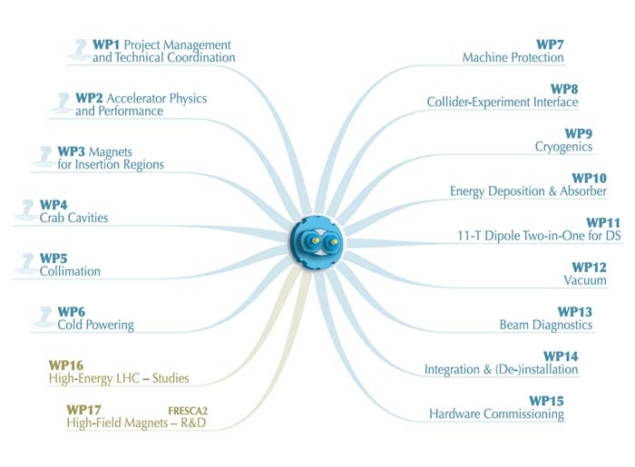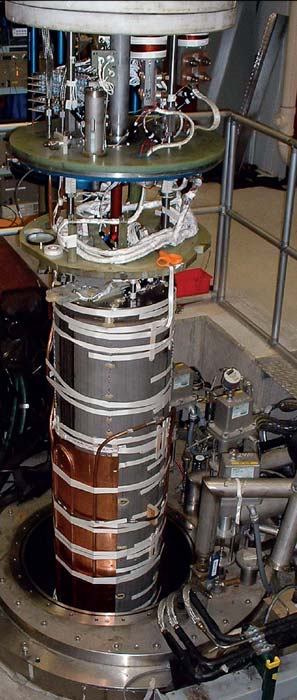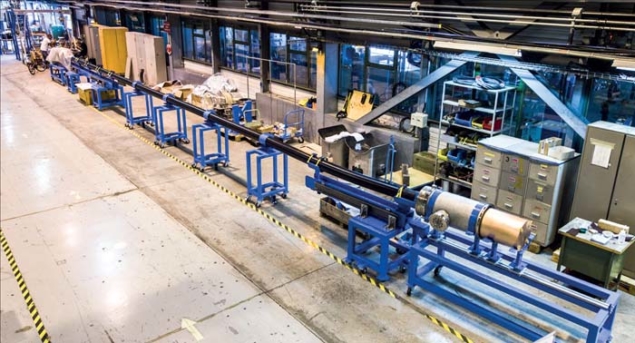Meetings highlight progress towards the LHC luminosity upgrade.

The LHC, the largest scientific instrument ever built, will extend its discovery potential at the beginning of the next decade through a fivefold increase in luminosity beyond the design value, in a new configuration called the High Luminosity LHC (HL-LHC). This extraordinary technical enterprise will rely on a combination of cutting-edge 11–13 T superconducting magnets, compact and ultraprecise superconducting radio-frequency cavities for beam rotation, as well as 300-m-long, high-power superconducting links with zero energy dissipation. In addition, the higher luminosities will make new demands on vacuum, cryogenics and machine protection, and will require new concepts for collimation and diagnostics, as well as advanced modelling for the intense beams.

Now, as the LHC nears the end of its first long run – from March 2010 to March 2013 – preparation work for this major upgrade is gathering speed. The past year has seen major developments in some of the key superconducting technologies, in particular for the new high-field magnets and the high-power links. Meanwhile, important decisions have been taken within the HiLumi LHC Design Study, which was launched just over a year ago. Supported in part by funding from the Seventh Framework Programme (FP7) of the European Commission (EC), this is the first phase of the larger HL-LHC project.
Broad collaboration
Towards the end of 2012, two meetings provided the opportunity for people involved at these accelerator frontiers to review progress and plan future activities, not only within their institutes around the world but also with industrial partners. On 14–16 November, the INFN Frascati National Laboratory was host to the 2nd Joint HiLumi LHC–LARP Annual Meeting. This brought together some 130 experts from Europe, Japan, Russia and the US LHC Accelerator Research Program (LARP). Three weeks later, on 4–5 December, a workshop on “Superconducting technologies for next-generation accelerators” took place at CERN organized by the HiLumi LHC Design Study in conjunction with the Test Infrastructure and Accelerator Research Area (TIARA) project, which is also co-funded by the EC under FP7. The workshop attracted more than 100 specialists, half from industry and half from laboratories and institutes. The aim was to explore the technical challenges emerging from the design of new accelerators and to match them with state-of-the-art industrial solutions.

Superconductivity has been the most important enabling technology in particle accelerators for the past 30 years – since the time of CERN’s Intersecting Storage Rings (the first accelerator to employ superconducting magnets during operation) and Fermilab’s Energy Doubler. The latter, later renamed the Tevatron, was the first large-scale superconducting system and it paved the way for all of the subsequent superconductivity projects, including the HERA collider at DESY, phase II of the Large Electron–Positron collider at CERN, the TRISTAN electron–positron collider at KEK and the Relativistic Heavy-Ion Collider at Brookhaven National Laboratory. Today, superconductivity is the core technology of the LHC, which employs some 1700 large superconducting magnets (dipoles and quadrupoles) and nearly 8000 superconducting corrector magnets, all cooled by more than 100 tonnes of superfluid helium.

Image credit: Fermilab.
The LHC’s main dipoles are 8 T superconducting magnets made from coils of niobium-titanium (NbTi) alloy. To allow the installation of additional collimators to deal with the increased luminosity in the HL-LHC, in 2010 CERN’s Lucio Rossi suggested replacing some of the 8 T dipoles with shorter 11 T magnets based on niobium-tin (Nb3Sn), which is superconducting at a higher temperature than NbTi. This idea also interested Fermilab, which has a high-field magnet R&D programme aimed at developing magnets for future machines such as a muon collider. CERN and Fermilab began to collaborate and by the spring of 2012 they completed a 2-m-long Nb3Sn dipole. In summer it was tested at 1.9 K in the Fermilab Vertical Test Facility, reaching a current of 11.2 kA and a calculated field of 10.4 T.
Such developments feed directly into the HiLumi LHC Design Study, which covers six work-packages (WP) of the larger HL-LHC project. The work of the design study is overseen by project management (WP1), which has CERN’s Hermann Schmickler as its new technical co-ordinator. Various committees and bodies, in particular the newly formed HL-LHC Co-ordination Group, ensure the necessary link between the machine-upgrade and the detector-upgrade projects, under the supervision of CERN management. The recent Joint HiLumi LHC–LARP Annual Meeting reviewed their progress as well as the headway that has been made towards a final layout for the accelerator upgrade.
Good progress
The main target for the HL-LHC is to achieve an integrated luminosity of 250 fb–1 a year and a total of 3000 fb–1 over 12 years. A key step in reaching this target lies in reducing the β* function (related to the focal length) at collision. With this in view, the team working on accelerator physics and performance (WP2) has collaborated closely with members of the LHC injector upgrade project as well as the current LHC operation group. As a result, they have defined possible sets of machine optics (in relation to β* and the crossing angle) and beam parameters (emittance, bunch spacing, bunch charge) that can achieve their goal. A further important development in WP2 is the recent, successful test in the LHC of luminosity-levelling by varying β*.
The conceptual design of the new D1 dipoles for the IRs is being steered by the KEK laboratory in Japan
A reduced β* in turn requires a redesign of the magnets in the insertion regions (IRs) where the collisions occur, which is the task of WP3. One important decision, taken in July in collaboration with WP2 and WP10 of HL-LHC (energy deposition and absorber), was to opt for the maximum possible aperture for the quadrupoles of the inner triplets: 150 mm of coil-free bore. This choice was based on successful tests within US-LARP of a 4-m-long, 90 mm aperture quadrupole and a more recent 1-m-long structure with a 120 mm aperture, both based on advanced Nb3Sn superconductor. In light of this decision, the teams working on accelerator physics and magnets in US-LARP are adjusting their plans and preparing a construction project for 2015.
While the work of WP3 has focused on providing major input to the choice of the quadrupole aperture, a decision on shielding has been made to use tungsten elements and a beam screen. At the same time, the conceptual design of the new D1 dipoles for the IRs is being steered by the KEK laboratory in Japan, where teams have analysed the performance of three possible apertures. The proposal is to have an 8-m-long magnet operating at 5 T.

To make the decreased β* most effective, the HL-LHC will use superconducting “crab cavities” to rotate particle bunches before they collide. These special radio-frequency cavities, which are the focus of WP4, may also provide levelling of the luminosity during the beam spill. The conceptual and technical design of three compact cavities (“4-rod”, “double ridge” and “quarter-wave”) has now been completed successfully. The new Crab Cavity Technical Co-ordination Working Group will, after the first long shutdown of the LHC, oversee preparation for the integration of crab cavities in the LHC and the preliminary tests in the Super Proton Synchrotron in 2015. Laboratory tests of a prototype 4-rod crab cavity built from bulk niobium superconductor by Lancaster University and the Cockcroft Institute in the UK began in November at CERN, while a prototype of the double-ridge type is under final preparation by a team from SLAC and Old Dominion University (ODU) at Jefferson Lab in the US, with tests foreseen by the beginning of 2013. A prototype of the quarter-wave type is under manufacture at Brookhaven National Laboratory, also using bulk niobium.
The HL-LHC will require higher beam currents, so new collimators will be necessary to protect the magnets from the 500 MJ of stored energy in each beam. The collimation team (WP5) has made the first steps towards the design of new IR collimation, with close collaboration between teams at CERN and from US-LARP. Tracking simulation tools have been set up to calculate losses by performing multi-turn tracking of the collision products, which can induce significant losses in the matching sections and dispersion suppressors at Point 1, Point 2 (with ions) and Point 5.
A further challenge for the HL-LHC project is to relocate equipment such as power convertors away from the tunnel to avoid radiation damage to electronics as well as to ease installation and integration of new equipment near the high-luminosity IRs, which are already crowded. This will require superconducting links that can transport high currents (up to 150 kA DC per line) from power supplies at ambient temperature on the surface to components operating at 1.9 K in the tunnel, some 100 m below ground. Work on this “cold powering” has started well ahead of schedule in WP6, with a study made of possible powering layouts for the new quadrupole magnets in the IRs, based on input concerning features of the optics and magnets agreed with WP2, WP3 and WP7 of HL-LHC (machine protection). Preliminary studies of the integration of the cold-powering system in the LHC machine have also been performed.
Cables built from tapes of copper and either HTS or MgB2 have been built and tested at CERN
In the LHC, current leads that incorporate a high-temperature superconductor (HTS) supply currents of up to 13 kA to the magnets in the tunnel. For the upgrade, CERN has been working with the Italian company Columbus to develop new superconducting wires based on magnesium diboride (MgB2), which has a lower operating temperature than HTS – the former being superconducting at the operating current at up to 25 K rather than 35–50 K with the latter – but is considerably less expensive. Until now, only flat ribbons of MgB2 have been available but CERN and Columbus have jointly developed round wires that are more suitable for the higher currents required for the HL-LHC. Cables built from tapes of copper and either HTS or MgB2 have been built and tested at CERN, and multi-cable assemblies have also been designed and constructed. Tests of the first 20 kA superconducting link are now taking place at CERN in the new test-station that has been set up in building SM18.

Advanced know-how
New and more advanced superconducting devices lie at the heart of not only the HL-LHC but of other large projects, such as the Facility for Antiproton and Ion Research at GSI, the XFEL at DESY and the European Spallation Source (ESS) in Lund. The workshop held in December on superconducting technologies was therefore based on talks about the HiLumi LHC Design Study, TIARA and the ESS, interweaved with presentations by representatives from industry. Companies also had stands and meeting points to provide the opportunity to exchange ideas and information.
One point of discussion was the model for laboratory–industry relations. Both the approach based on “turnkey” contracts (where only the main characteristics of equipment are laid down in a functional specification) and an approach based on “built-to-print” contracts (where industry is responsible for a specific manufacture rather than for the full product) can be effective and yield the best value for money. For equipment that has been fully or even partly developed for previous projects, the turnkey model can probably be used, thus minimizing the human resources required at the laboratory. When R&D is long and based on new types of equipment, such as for the LHC upgrade, the built-to-print model is probably more suitable. However, in both cases, only a close laboratory–industry relationship during construction can avoid misunderstandings and painful extra costs. There were also discussions on how to improve the exchange of information on technologies, processes, materials, facilities, work organization and training of the next generation of engineers and technicians.
In addition to reviewing progress in superconducting technologies for the HL-LHC, the workshop looked forwards in considering items that will need to be procured once the project is approved by CERN Council; in principle in June, in the context of the updated European Strategy for Particle Physics. The requirements include: 20 large superconducting Nb3Sn quadrupoles rated for 12–13 T, 10 of which will be supplied by the US; five large 6 T superconducting dipoles (D1) in NbTi from Japan; five large 4–4.5 T superconducting dipoles (D2); five large superconducting twin quadrupoles (Q4) rated for 8 T; six to twenty superconducting 11 T twin dipoles in Nb3Sn; five large SC twin quads (Q7) rated for 7 T; five to six modules each of three superconducting crab cavities; 3 km of superconducting links rated for 50–150 kA; and a number, still to be defined, of corrector-magnet packages. These will all have their own cryostats and will need new cryogenic plants and vacuum requirements. In addition, there will be new collimators, some equipped with special wire to compensate inter-beam effects near collision, as well as other equipment that is under development.
The workshop was the first step in communicating with industry to find partners for new development and construction, with a goal of maximizing the industrial return and incrementing the industrial capability of the EU. The aim is to achieve full funding of the project, including design and prototyping, totalling around SwFr750 million by 2015, with an additional SwFr200–250 million from external collaboration with the US and Japan. Construction and testing would then take place between 2016 and 2020, ready for installation at the end of 2021.
• The next joint HiLumi LHC–LARP Annual Meeting is planned to take place at the Cockcroft Institute, Daresbury Laboratory, on 12–15 November 2013, while in May 2013 the collaboration will meet at the joint LARP–HiLumi LHC Annual Meeting in the US. For more about the workshop on “Superconducting technologies for next-generation accelerators”, see https://indico.cern.ch/conferenceDisplay.py?confId=196164. For more about HL-LHC, see http://cern.ch/hilumilhc.
Letting young scientists shine
A new section at the 2nd Joint HiLumi LHC–LARP meeting was the “Young Scientist Talk”, a session organized to showcase recipients of LARP’s Toohig Fellowship, which is awarded each year to two recent PhD recipients in physics or engineering. Toohig Fellows John Cesaratto and Valentina Previtali attended the meeting. Currently based at member institutions of LARP – Cesaratto at SLAC National Accelerator Laboratory and Previtali at Fermilab – they will also spend time at CERN as part of the fellowship. Cesaratto gave a talk on the control of beam instabilities in CERN’s Super Proton Synchrotron and Previtali presented first results from simulations of the hollow electron lens. They were joined by Meghan McAteer, a Marie Curie Fellow, who talked about optics measurements in the Boosters at Fermilab and CERN.
The section was convened by John Fox of SLAC and a member of LARP. He is chair of LARP’s Toohig Fellowship Committee and is keenly interested in promoting the work of young scientists. He believes that bringing young scientists to the conference is multi-valued, enabling the young Toohig Fellows to meet scientists at CERN and, conversely, allowing young scientists from CERN to meet members of LARP. Such opportunities to meet and strike up collaborations are important for young scientists at US labs, who get few chances to interact with the broader community.
The Toohig Fellowships are awarded in honour of the late Timothy Toohig, a physicist and Jesuit priest who devoted his life to promoting accelerator science and increasing understanding, communication and collaboration among scientists of all nations and religions. The fellowships are for two years, extendable to three, and are explicitly for postdoctoral research and development regarding the LHC.
• Lori Ann White, SLAC.





